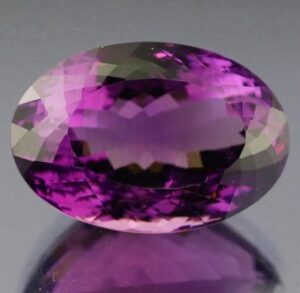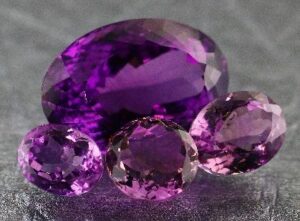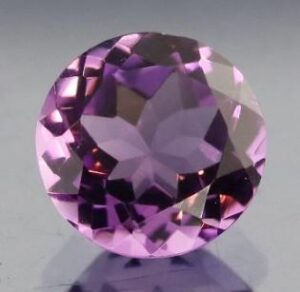Amethyst: Let us be Sober!
Most people know amethyst as the purple birthstone that can be found just about anywhere in different forms. Whether you are looking for a stunning pair of earrings or a towering geode beside your fireplace, amethyst is readily available at reasonable costs. Many use it for its

believed benefits and properties or as the perfect accent with that purple dress, but where did it come from? Where did the beliefs originate? Why can you find giant samples of amethyst but not other gems? Have a seat on your chair sample and let’s find out!
If you were born in February, there’s a good chance you have at least one amethyst sample either in your jewelry collection or somewhere in your home. If you were to have those same pieces prior to the 1800s, you wo
uld likely be rich or royalty! Amethyst was celebrated in myth and legend and used to be considered one of the cardinal gemstones alongside diamonds, emeralds, rubies, and

sapphires. These gems were regarded as precious above all others. However, when large deposits were discovered in Brazil and other locations, amethyst was demoted to a
semiprecious stone and itsvalue significantly decreased. Amethyst is a variety of quartz that ranges in hue from a light pinkish purple through violet into a deep, dark purple. Some refer to this hue as royal purple, which makes sense given its rich history and association with royalty and crown jewels. The large geodes that mesmerize us in shops and museums come mostly from volcanic rocks in Brazil but are mined all over the world including here in the United States. Unfortunately, you won’t find giant samples like that for the precious gems, but you can find them in citrine for us fall lovers and November birthdays.
 The meaning and use of amethyst vary between cultures and times. For example, it was used in ancient China as a tool to remove negative energies and the hazards of daily life, while medieval European soldiers wore amethyst for protection since they believed it could heal and keep them level-headed in battle.
The meaning and use of amethyst vary between cultures and times. For example, it was used in ancient China as a tool to remove negative energies and the hazards of daily life, while medieval European soldiers wore amethyst for protection since they believed it could heal and keep them level-headed in battle.
This belief is not so far off from Greek mythology, which is by far the most unique story and one that would be very useful today. The myth has a
 few variations, but the story goes that Dionysus (the god of wine) swore to slay the next person to cross his path after being insulted by a mortal. He created fierce tigers to carry out his will and the young Amethyste happened to become the target. She cried out to the goddess Diana, who answered by transforming her into a shimmering, white stone. Dionysus then wept tears of wine onto the stone after he realized his mistake, and it soaked up the wine until it glistened purple.
few variations, but the story goes that Dionysus (the god of wine) swore to slay the next person to cross his path after being insulted by a mortal. He created fierce tigers to carry out his will and the young Amethyste happened to become the target. She cried out to the goddess Diana, who answered by transforming her into a shimmering, white stone. Dionysus then wept tears of wine onto the stone after he realized his mistake, and it soaked up the wine until it glistened purple.
While this specific myth and its variations are not written in classical sources, it is historically written that the goddess Rhea gave Dionysus amethyst in order to preserve his sanity from the vine. The Greek word “amethystos” can be translated into “not intoxicated,” so it’s no surprise that Greeks used to consider the gem to be an antidote against becoming drunk and would drink from amethyst-carved goblets. Since drunken behavior is closely associated with unclear emotions and poor decisions, amethyst is then correlated with clarity of mind and control over life.

It is believed to have physical, emotional, and even spiritual benefits. While a good portion of these may be up for speculation, having a purple gem in your corner helping you sleep at night may not be the worst thing to believe in.
 If the legends and ancient Greeks can be trusted, draping clubs in amethyst may be the aesthetic of the future! For now, though, you can find some amethyst to adorn yourself and keep a clear mind with at Backroom Gems. Just don’t drink and drive… that’s a bad decision no matter what your gemstone tells you.
If the legends and ancient Greeks can be trusted, draping clubs in amethyst may be the aesthetic of the future! For now, though, you can find some amethyst to adorn yourself and keep a clear mind with at Backroom Gems. Just don’t drink and drive… that’s a bad decision no matter what your gemstone tells you.
